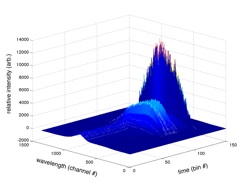Multivariate Measurements

The combination of tunable laser excitation, multi-channel detectors and computer control of spectrometer components allows us merge several spectroscopic measurements into multivariate measurements with the enhanced selectivity needed to study complex systems. In such systems, measuring the dynamic properties of probes is useful for characterizing samples in which medium features are too small for light imaging. Many variable combinations are possible; our past work emphasized emission wavelength and time (sometimes via frequency). The image on the right is an example of an emission decay matrix of PRODAN in DMPC vesicles. The relaxation rates and spectra of the PRODAN excited states stabilized in the lipid membrane can be recovered from this data set. Many other examples integrating excitation wavelength, emission wavelength, emission polarization and spatiotemporal dependence into multivariate measurements are possible.
Related Publications
• C.A. Roach and S.L. Neal, “Numerical Correction of Detector Channel Cross-Talk Using Full-Spectrum Fluorescence Correlation Spectroscopy,” Applied Spectroscopy, 2010 64(10); 1145-1153.
• S.L. Neal, “Frequency-Domain Multidimensional Fluorescence: A Route to Non-Parametric Fluorescence Decay Analysis,” Analytical Chemistry, 1997 69(24) 5109-5120.
• S.L. Neal, “Model-Independent Estimation of the Photokinetic Transfer Matrix via Dynamic Multidimensional Fluorescence,” Journal of Physical Chemistry A, 1997 101(37) 6883-6889.



For example, correlation spectroscopy measurements use spatiotemporal relationships in fluorescence intensities to measure fluorophore translational dynamics. Multicolor versions of these measurements have been limited to a few wavelengths and by distortions such as cross-talk (measuring green photons, for example, at the red photon detector). Recent work demonstrated simultaneous measurement of multiple fluorophores in polymer solutions and the utility of using numerical methods to avoid detector cross-talk.

The Exploratorium, 1994.